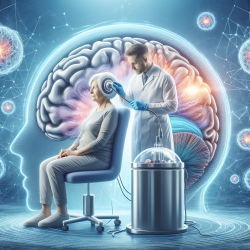Introduction
Alzheimer's disease remains a formidable challenge, with millions affected worldwide. However, recent research offers hope through a novel approach: repetitive transcranial magnetic stimulation (rTMS) targeting the precuneus. This blog explores the groundbreaking findings from the study "Precuneus magnetic stimulation for Alzheimer’s disease: a randomized, sham-controlled trial" and how practitioners can leverage these insights to enhance therapeutic strategies.
The Study at a Glance
The study conducted by Koch et al. involved a 24-week randomized, double-blind, sham-controlled trial focusing on patients with mild-to-moderate Alzheimer's disease. Participants were divided into two groups: one receiving precuneus rTMS and the other receiving sham stimulation. The primary outcome was the Clinical Dementia Rating Scale–Sum of Boxes (CDR-SB), with secondary measures including the Alzheimer's Disease Assessment Scale–Cognitive Subscale (ADAS-Cog), Mini-Mental State Examination (MMSE), and Activities of Daily Living (ADCS-ADL).
Key Findings
- Stability in Cognitive Function: Patients receiving precuneus rTMS maintained stable CDR-SB scores, while those in the sham group experienced cognitive decline.
- Improved Secondary Outcomes: The rTMS group showed significant improvements in ADAS-Cog, MMSE, and ADCS-ADL scores compared to the sham group.
- Neurophysiological Changes: Precuneus rTMS maintained cortical excitability and enhanced local gamma oscillations, unlike the sham group, which showed reduced excitability.
Implications for Practitioners
The study suggests that targeting the precuneus with rTMS could slow cognitive and functional decline in Alzheimer's patients. Practitioners can consider incorporating this non-invasive technique into treatment plans, potentially offering a new avenue for managing Alzheimer's disease. Moreover, the study emphasizes the importance of personalized approaches, as baseline cortical excitability correlated with treatment response.
Encouraging Further Research
While the results are promising, further research is necessary to refine rTMS protocols, explore long-term effects, and investigate the combination of rTMS with cognitive training. Practitioners are encouraged to stay informed about ongoing studies and advancements in this field.
Conclusion
The study by Koch et al. opens new possibilities for Alzheimer's treatment through precuneus rTMS. By embracing these findings, practitioners can enhance their therapeutic arsenal and contribute to improving the quality of life for Alzheimer's patients.
To read the original research paper, please follow this link: Precuneus magnetic stimulation for Alzheimer’s disease: a randomized, sham-controlled trial.










